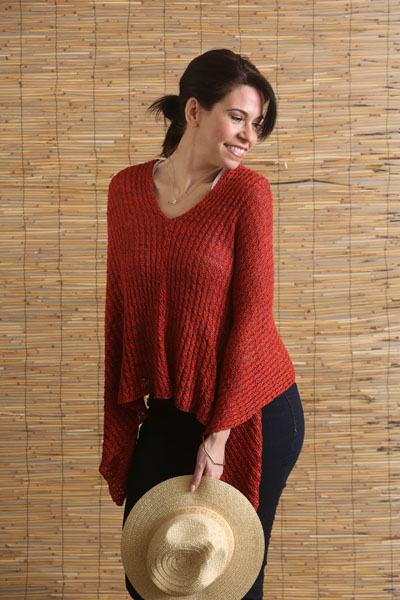
The original inspiration for this design was the way the water glimmers in the late morning as the haze lifts off the Pacific and the sand reflects the light of the sun back towards the sky as the temperature begins to rise. It’s the perfect poncho to slip on over a tee for a chilly morning walk.
Skill Level: Intermediate
Size: Finished to fit bust sizes 34 (40, 48)”
Gauge: 32 sts and 28 rows = 4” [10 cm] in St st before blocking.
24 sts and 26 rows = 4” [10 cm] in St st after blocking.
Materials
Yarn:
![]() Blue Heron Rayon Metallic (85% Rayon, 15% Metallic; 550 yards [503 meters]/227 grams): Carnelian, 2 (2, 3) skeins.
Blue Heron Rayon Metallic (85% Rayon, 15% Metallic; 550 yards [503 meters]/227 grams): Carnelian, 2 (2, 3) skeins.
Needles: US size 5 (3.75 mm): bamboo 24” circular
Notions: Tapestry needle; point protectors
Pattern Notes
This poncho is knit as a rectangle, blocked, folded in half then seamed along the shoulder.
The suggested yarn, Blue Heron Rayon Metallic, when knit in the suggested stitch stretches when worn. To minimize the impact of this when wearing the garment, the piece is knit to a smaller dimension then wet blocked to the appropriate size.
When rolling Blue Heron Rayon Metallic into a ball it is suggested that you do not use a yarn swift nor make a center pull ball. Enlist the help of a willing accomplice to make a ball with you or put the hank over the back of two chairs. This yarn is best made into a ball from which the yarn is pulled from the outside. Once it is made into a ball, store each ball in its own a zipper top bag to prevent it from unrolling. When knitting, knit from the bag for the same reason.
Pattern Stitch: A trompe-l’oeil faux cable created using a k2, p1 stitch repeat with a cross over every 4th row formed by knitting through the back of the second stitch on the left needle then knitting the first stitch on the left needle before dropping both and proceeding to the purl. The reason for knitting through the back loop is to minimize the stretching of the fabric when the poncho is worn.
Pattern
CO 121 (139, 157) sts.
Row 1: S1 as if to purl, *k2, p1; rep from * across.
Row 2: S1 as if to purl, *p2, k1; rep from * across.
Row 3: S1 as if to purl, *knit in to back of the second stitch on the left needle, do not drop it nor the first stitch on the left needle, knit the first stitch on the left needle, drop both off the left needle (two knit stitches now on the right needle), p1; rep from * across.
Row 4: Repeat Row 2
Rep Rows 1-4 until work measures approximately 51 (57, 63)”, having just completed a Row 4
Repeat Rows 1-2.
BO using a stretchy bind-off.
Finishing
Weave in ends.
Blocking is accomplished by rolling up the fabric loosely and resting it in a sink of warm water, 110 degrees F. There may be some color loss depending upon the temperature of the water. Add 1 cup white vinegar if there is any color loss. When the garment sinks into the basin allow it to sit for approximately 20 minutes; do not agitate the water.
If vinegar was used, rinse the fabric.
Remove the garment from the sink, unroll it, place it between two bath towels. Beginning at one edge, roll the three layers and squeeze the rolled up set of three layers to release some of the water.
Block the rectangle to 25 (28, 32)” x 55 (61, 67)”.
When the rectangle is dry, with the WS facing, fold the left side over the right. The RS is now facing and the garment is folded to appear as it would when worn. To seam, turn the piece inside out. With WS facing, graft the shoulder stitches together.
Working from the CO edge corner of the fabric, begin to sew the seam along the top of the rectangle. Suggested seam length 13 (16, 19)” will result in a neck opening of approximately 12”


Has anyone tried a variant doing this in stockinette, running it up one side, then attaching it coming down the other? Maybe with a taper to a V at the bottom?